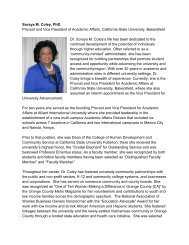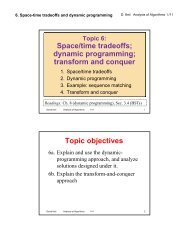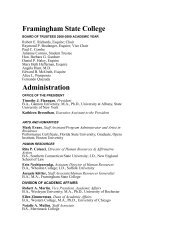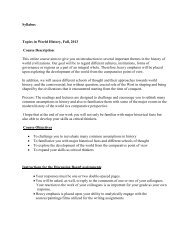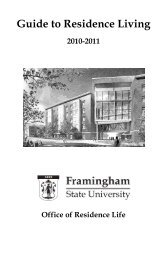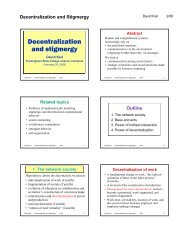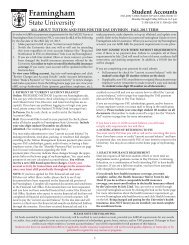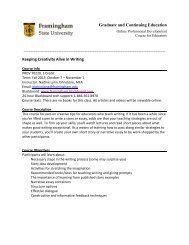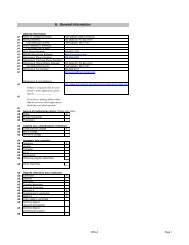2008-2009 - Framingham State University
2008-2009 - Framingham State University
2008-2009 - Framingham State University
You also want an ePaper? Increase the reach of your titles
YUMPU automatically turns print PDFs into web optimized ePapers that Google loves.
MISSION STATEMENT<br />
Committed to Student Success<br />
<strong>Framingham</strong> <strong>State</strong> College’s faculty and staff<br />
demonstrate their commitment to each and<br />
every student’s success by ensuring that<br />
student learning is paramount. From faculty, who<br />
are available outside of class, to staff, who are<br />
dedicated to customer service, we are always<br />
looking to make your experience at <strong>Framingham</strong><br />
<strong>State</strong> an enjoyable and rewarding one.<br />
Yesterday and Today<br />
<strong>Framingham</strong> <strong>State</strong> College began in a building,<br />
still standing today, on the corner of Lexington<br />
Common, on July 3, 1839. It had as its mission<br />
the training of teachers, and it was the first<br />
state-supported normal school (the name for a<br />
school which trains teachers) in America. Twice<br />
it outgrew its accommodations, moving first to<br />
West Newton, and then to its present location<br />
on Bare Hill in <strong>Framingham</strong> in 1853. From the<br />
beginning, the Normal School met the challenge<br />
of being the first model by educating excellent<br />
teachers who were in demand for the common<br />
schools of Massachusetts and, indeed, for<br />
schools throughout the nation. From the first<br />
class, Normal School graduates participated in<br />
the new education for the blind and deaf. They<br />
traveled to the South and to the West to teach<br />
in schools being organized for Blacks and Native<br />
Americans, and they went as missionaries to<br />
distant lands.<br />
From 1848 to 1898 <strong>Framingham</strong> also conducted<br />
an advanced program for women who aspired<br />
to careers in high school and college teaching,<br />
school administration, law and medicine, thus<br />
opening unprecedented educational and career<br />
opportunities for women. There were principals,<br />
professors, doctors and writers among the early<br />
graduates, as well as women who participated<br />
in the suffrage and temperance movements<br />
and in all of the significant educational and<br />
social reforms of the nineteenth century. Finally,<br />
at the close of the century, the first teachers<br />
of household arts were graduated from a new<br />
program at <strong>Framingham</strong>, laying the foundation<br />
for studies in nutrition and food science, as well<br />
as clothing and textiles.<br />
The student body increased steadily during<br />
the twentieth century, and with it the size of<br />
the campus and the number of buildings. New<br />
programs and courses marked the increasingly<br />
professional character of the education<br />
1<br />
offered, while extracurricular organizations<br />
were formed to enrich student life. In 1932 the<br />
Massachusetts Normal Schools became <strong>State</strong><br />
Teachers Colleges, and in 1960 they became<br />
<strong>State</strong> Colleges with a mandate to develop liberal<br />
arts curricula. <strong>Framingham</strong>, which had served<br />
only women, became coeducational in 1964.<br />
The College has continued to add departments<br />
such as Economics, Philosophy, Sociology and<br />
Psychology, as well as career-oriented programs<br />
in Medical Technology, Computer Science,<br />
Media Communications and Nursing, among<br />
others, to increase the options for students, and<br />
to meet the needs of the Commonwealth.<br />
The College was empowered to grant its first<br />
graduate degree, the Master of Education, in<br />
May 1961. This was a part-time degree program.<br />
Full-time day graduate programs, currently<br />
limited to only the Master of Science, became<br />
available in 1967.<br />
Authorization for the Master of Arts in<br />
Administration and in Counseling Psychology,<br />
and the Master of Science in Food and Nutrition<br />
came the following year.<br />
In 1980, four of the options in the Master of<br />
Arts program were established: Business<br />
Administration, Educational Leadership, Health<br />
Care Administration, and Public Administration.<br />
The Master of Business Administration degree<br />
was approved in 2006. The Master of Science in<br />
Nursing, with concentrations in Education and<br />
Leadership, was approved in 2007.<br />
A leader in educational technology, in September<br />
2001 <strong>Framingham</strong> <strong>State</strong> College began its<br />
first online degree program - the Master of<br />
Education with a concentration in Curriculum<br />
and Instructional Technology.<br />
Public Higher Education System<br />
Mission <strong>State</strong>ment<br />
The public college and university system in the<br />
Commonwealth of Massachusetts comprises<br />
fifteen community colleges, nine state colleges<br />
and the five campuses of the <strong>University</strong> of<br />
Massachusetts. The system exists to provide<br />
accessible, affordable, relevant and rigorous<br />
academic programs that adapt to meet changing<br />
individual and societal needs for education and<br />
employment. All campuses are committed to<br />
operating effectively and efficiently in order<br />
to maintain tuition and fees at a level as low<br />
FRAMINGHAM STATE COLLEGE GRADUATE CATALOG <strong>2008</strong>–<strong>2009</strong>



